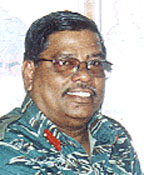Early warning pilot project for Mahaica Creek
The Civil Defence Commis-sion (CDC) has been preparing for the scheduled rainy season and its Head, Colonel (rtd) Chabilall Ramsarup says that in the event of any unforeseen crisis, it would be prepared to minimise the level of disaster.
In a recent interview with Stabroek News, Ramsarup said that while the May/June rainy season is expected to be normal, the commission is not taking any chances. Last month Chief Hydromet Officer Bhaleka Seulall announced that based on recent statistical and forecast models, the rainfall during the upcoming season is expected to be “normal”. She explained that this would include short periods of heavy downpours. According to her, there is expected to be about 19-20 rain days (days when rainfall is equal to or greater than 1 mm) during the months of May, June and July.
Meanwhile, Ramsarup said that a lot of resources have been put into training persons, especially residents of the interior regions. Recently, the commission teamed up with the Red Cross to train personnel in Shelter Management. He said that in 2005, when there was need to establish shelters, the military was used to oversee the operation. Ramsarup stated that this was not the ideal situation and the commission was trying to correct it by equipping persons who will be able to manage them more effectively. He opined that these persons will be better able to address the social needs of the communities, in case there is any disaster. However, he pointed out that the military still has an important part in the commission’s plans.
Additionally, courses have also been held in Warehouse Management. He explained that this is in case it became necessary to remove items from the coast to the interior regions for storage. He said this would enhance safe transport and accountability. He added that persons are also being trained in Damage Assessment and Needs Analysis (DANA), which is a formula that persons can use to ascertain the amount of damage in case a disaster of any kind happens.

Ramsarup noted that the CDC is responsible mainly for dealing with issues of “mitigation and response” during disasters. He explained that the body’s emphasis is on “disaster risk reduction,” since no one can predict what will happen when disasters come.
International organisations have also been partnering with the CDC. Ramsarup stated that the Japan International Cooperation Agency (JICA) has teamed up with the Government of Guyana to help in the area of early warning for natural disasters. He said Guyana was one of five states identified in the region to benefit from this programme. And according to him, although the Sea Defence Unit is the lead agency in this project, the CDC is also actively involved. He said the Mahaica River has been chosen as the site for this pilot project and the equipment would be used to identify and warn residents about disasters and what actions they should take. Under this programme residents will be trained to utilise the equipment, he further stated.
Additionally, the United States Southern Command (USSouthCom) has partnered with the CDC to help in the area of Flood Hazard Mapping.
He said that the body is currently testing the equipment and software in the Mahaicony region. He said local agencies are being trained to operate the software and stated that once it is suitable to Guyana, it will be utilized.
Ramsarup further said improving its IT sector is one of the major goals of the CDC. He stated that the CDC is currently in the process of upgrading its operations room. He also said that efforts are being made to improve its communications department, so as to facilitate the better transfer of information between Georgetown and other locations.
On a practical front, Ramsarup also disclosed that the Commission owns two water tenders, two trucks and a series of boats and engines. Although, he was unable to say exactly how many boats and engines the body has in its fleet, he expressed confidence that the number was adequate.
He added that the body also benefits from the help of other stakeholders. He stated that the Commission, depending on the gravity of the situation, holds co-ordinating conferences with different stakeholders. These include the Ministry of Health, the Agriculture Ministry, the River and Sea Defence Board, The Hydromet Office and the Guyana Lands and Surveys Commission as well as some non-governmental organisations.
This is the retired Colonel’s second stint as the Head of the CDC. He had previously held the post for a period beginning in 2005, before he took up the post as the Commissioner of Customs and Trade Administration within the Guyana Revenue Authority (GRA). In January, he returned to the CDC, replacing Major General (ret’d) Michael Atherly, who was promoted to a post within the Office of the President.
According to the CDC’s website, “the Civil Defence Commission (CDC) was established in the year 1982 to make plans and conduct operations to deal with all types of disasters in Guyana. By 1985 a comprehensive National Disaster Preparedness Plan was documented and put into use.”
The website further said that the Commission was initially operated under the authority of the Office of the Prime Minister but was subsequently moved to the Office of the President in 1992.




